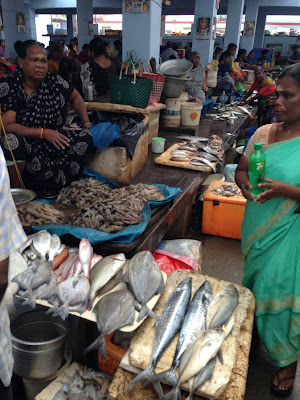A trip to India is always full of surprises, and this trip kept delivering new experiences.
 |
| Bougainvillea cascades over a garden wall in the French Quarter |
First, there was the life-changing decision to strengthen my connection to Shantivanam by becoming a Benedictine oblate, then there was the time spent at the Mattindia clinic where my hayfever, oedema and sleep apnoea were all miraculously cured.
Finally, there was Pondicherry, with its very French atmosphere and culture.
But while I had anticipated this in what I had read about "Pondy," I knew nothing of Sri Aurobindo, The Mother, nor of the golden sphere of the Matrimandir.
Aurobindo was an anti-imperial nationalist, a guru, poet and philosopher. Born in 1872, he was a couple of generations ahead of his time, with idealistic spiritual ideas that found a sympathetic audience in the open-mindedness of Indian philosophy.
His collaborator was Mirra Alfassa, a Jewish woman born in Paris of Turkish and Egyptian parents. She is known simply as "The Mother" and was deeply spiritual from a very young age. Together with Aurobindo, she is revered in photographs in shops, hotels and other businesses throughout Pondicherry.
 |
| At Auroville, with the Matrimandir in the background |
The great project of this esoteric partnership was the founding of a Utopian community at Auroville, centred around a golden dome incorporating an enormous crystal, made by the German optical firms of Schott and Zeiss. It really was a symbol of the era - the Nineteen-Sixties, but however one might dismiss the tree-hugging hippies, the atmosphere of Auroville is amazing.
This was a fitting end to my 3-month sojourn, and I left Pondicherry to fly home just a couple of days after sitting and soaking up the overwhelming peace of Auroville.
I came home with serious projects to tackle. The Building Blocks project in Bangalore needs a lot of thought, and I have had conversations with the Ambats in Bangalore, discussing various ideas.
But first. . . . Europe is facing the greatest humanitarian crisis of our lifetime, and I cannot stay in Lincoln. I fly out to Greece very soon.
You can follow my plans and project at my new blog "In Search of a Better Life" - just click on the title. I have kept your name and address on the mailing list, so you'll get regular updates from Samos; - just drop me an email if you want to opt out.
Thanks for all your encouraging feedback; - do please keep in touch.




































